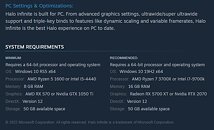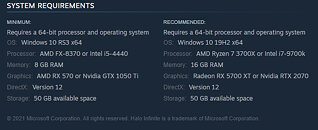T0@st
News Editor
- Joined
- Mar 7, 2023
- Messages
- 2,857 (3.74/day)
- Location
- South East, UK
| System Name | The TPU Typewriter |
|---|---|
| Processor | AMD Ryzen 5 5600 (non-X) |
| Motherboard | GIGABYTE B550M DS3H Micro ATX |
| Cooling | DeepCool AS500 |
| Memory | Kingston Fury Renegade RGB 32 GB (2 x 16 GB) DDR4-3600 CL16 |
| Video Card(s) | PowerColor Radeon RX 7800 XT 16 GB Hellhound OC |
| Storage | Samsung 980 Pro 1 TB M.2-2280 PCIe 4.0 X4 NVME SSD |
| Display(s) | Lenovo Legion Y27q-20 27" QHD IPS monitor |
| Case | GameMax Spark M-ATX (re-badged Jonsbo D30) |
| Audio Device(s) | FiiO K7 Desktop DAC/Amp + Philips Fidelio X3 headphones, or ARTTI T10 Planar IEMs |
| Power Supply | ADATA XPG CORE Reactor 650 W 80+ Gold ATX |
| Mouse | Roccat Kone Pro Air |
| Keyboard | Cooler Master MasterKeys Pro L |
| Software | Windows 10 64-bit Home Edition |
The latest patch for Halo Infinite has introduced an undesired side effect for a select portion of its PC platform playerbase. Changes to minimum system specification requirements were not clarified by 343 Industries in their patch notes, but it appears that the game now refuses to launch for owners of older GPU hardware. A limit of 4 GB of VRAM has been listed as the bare minimum since Halo Infinite's launch in late 2021, with the AMD Radeon RX 570 and Nvidia GTX GeForce 1050 Ti cards representing the entry level GPU tier, basic versions of both were fitted with 4 GB of VRAM as standard.
Apparently users running the GTX 1060 3 GB model were able to launch and play the game just fine prior to the latest patch, due to it being more powerful than the entry level cards, but now it seems that the advertised hard VRAM limit has finally gone into full effect. The weaker RX 570 and GTX 1050 Ti cards are still capable of running Halo Infinite after the introduction of season 3 content, but a technically superior piece of hardware cannot, which is unfortunate for owners of the GTX 1060 3 GB model who want to play Halo Infinite in its current state.



343 Industries is yet to respond to these VRAM limitation findings, but those affected are remaining hopeful that the developers are working on a fix. The system requirements for Halo Infinite have not shifted much between 2021 and 2022 on the Steam product page. The Microsoft Store listing has not be updated to reflect the latest VRAM limitation introduced in the Season 3: Echoes Within update. Ray tracing is a notable addition to the latest version of Halo Infinite, since it has been long promised graphical feature - 343 Industries did announce an ongoing collaboration with AMD on ray tracing acceleration implementations in late 2021.



Those affected by the 4 GB VRAM limit will likely have to move on and upgrade to a more modern graphics card, and the timing is not too bad due to the GPU market stabilizing - with improved availability and slightly more sensible pricing in effect. Intel's Arc series has even injected some much needed extra competition into the sector, despite a rocky launch last year. There are some deals to be had out there, due to aggressive price cuts and transitioning to newer GPU architectures.



View at TechPowerUp Main Site | Source
Apparently users running the GTX 1060 3 GB model were able to launch and play the game just fine prior to the latest patch, due to it being more powerful than the entry level cards, but now it seems that the advertised hard VRAM limit has finally gone into full effect. The weaker RX 570 and GTX 1050 Ti cards are still capable of running Halo Infinite after the introduction of season 3 content, but a technically superior piece of hardware cannot, which is unfortunate for owners of the GTX 1060 3 GB model who want to play Halo Infinite in its current state.



343 Industries is yet to respond to these VRAM limitation findings, but those affected are remaining hopeful that the developers are working on a fix. The system requirements for Halo Infinite have not shifted much between 2021 and 2022 on the Steam product page. The Microsoft Store listing has not be updated to reflect the latest VRAM limitation introduced in the Season 3: Echoes Within update. Ray tracing is a notable addition to the latest version of Halo Infinite, since it has been long promised graphical feature - 343 Industries did announce an ongoing collaboration with AMD on ray tracing acceleration implementations in late 2021.



Those affected by the 4 GB VRAM limit will likely have to move on and upgrade to a more modern graphics card, and the timing is not too bad due to the GPU market stabilizing - with improved availability and slightly more sensible pricing in effect. Intel's Arc series has even injected some much needed extra competition into the sector, despite a rocky launch last year. There are some deals to be had out there, due to aggressive price cuts and transitioning to newer GPU architectures.



View at TechPowerUp Main Site | Source





